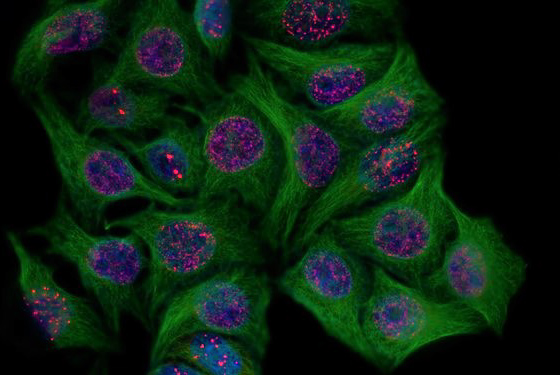Scientists at the MRC Laboratory of Medical Sciences (MRC LMS) have today published new guidelines for the use of biomarkers in the study of cellular senescence in a range of tissue types. Senescence is now recognised as a pivotal process in many diseases, particularly those associated with inflammation, ageing and multimorbidity, however variability in the presentation of senescence in different cell types in laboratory conditions and tissue samples has hampered research reporting. Today’s new guidelines developed by a global collaboration of senescence researchers including Professor Jesús Gil from the MRC LMS Senescence Research Group will help standardise and harmonise reporting of senescence research, increasing the power of research reporting in this fast-moving field.
By LMS Staff Member
August 8, 2024
Time to read: 3 minutes

At certain stages in life, such as embryonic development, healing after an injury or ageing, cells enter a stage that is called “senescence”. Targeting senescence as a therapeutic strategy holds great promise for addressing age-associated diseases, but until today’s publication of new guidelines, the research community lacked clear standards for identifying these cells in the lab.
Senescence is usually triggered by cellular stress, causing cells to stop dividing and instead release increased amounts of signaling molecules into their surroundings. While transiently induced senescence is a vital part of the healing process, chronic senescence has become widely implicated in tissue damage and many age-related diseases and is a fast-growing area of scientific exploration.
Recent advancements in tools for studying senescence have opened new possibilities for understanding its diverse roles in health and disease and for exploring senescent cells as therapeutic targets. Traditional markers of senescence, originally discovered and validated in laboratory cell culture models, however, often do not function well as identifiers of senescence in natural tissue environments, so identifying and characterizing senescent cells in tissues and living organisms has presented special challenges. Overcoming these challenges was the impetus leading to today’s newly published guidelines. They were created by a global collaboration of leaders in cellular senescence, including Professor Jesús Gil, Head of the Senescence Research Group at the MRC LMS, united under the banner of the Wiggers-Bernard initiative. Together, they have developed the “MICSE” guidelines, short for “Minimal Information on Cellular Senescence Experimentation in vivo”, which have today been published in the scientific journal “Cell”. The guidelines provide a uniform toolset of markers and techniques needed to study senescent cells in their natural environment within the tissue.
Jesús has said:
“In the last decade, it’s become clear that senescence plays a key role in cancer, ageing and age-related diseases, but understanding how we can identify senescent cells in the lab has been one of the biggest challenges for researchers in the field. These new guidelines set clear standards which will allow research to progress more quickly and reach its translational potential.”

By working together and agreeing on a universal framework, these guidelines will ensure researchers speak the same “language” in their experimental work. Establishing the MICSE guidelines will help harmonise senescence research reporting which in turn will help meet some of the most pressing challenges of our society including ageing and multimorbidity and the high socio-economic burden associated with them – both key areas of focus in the MRC LMS’s overarching research strategy.
Read the full paper: